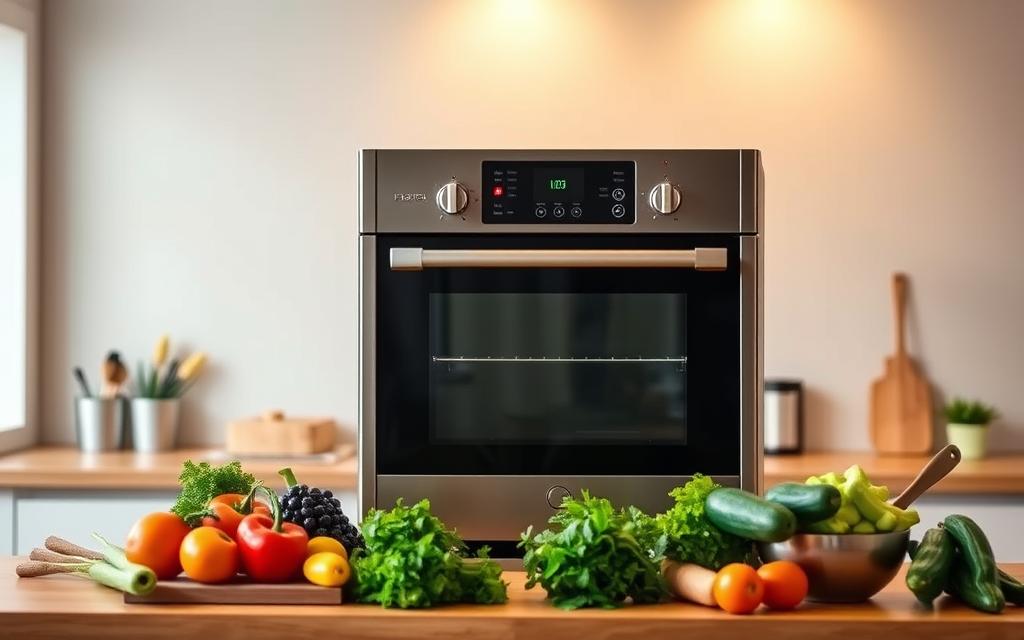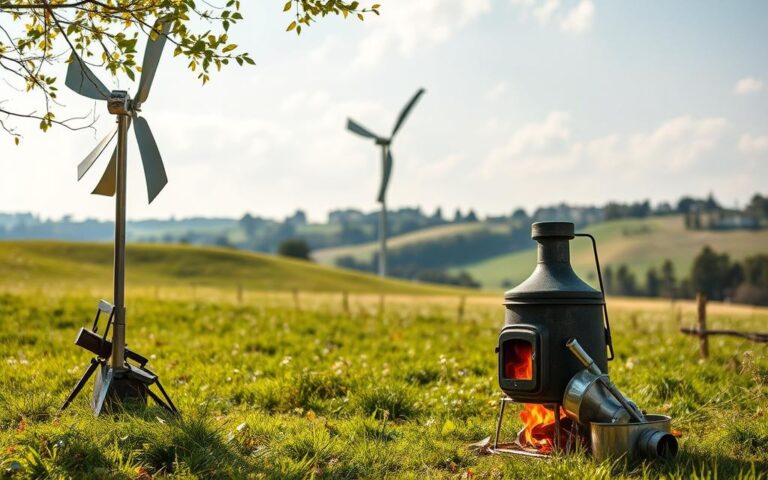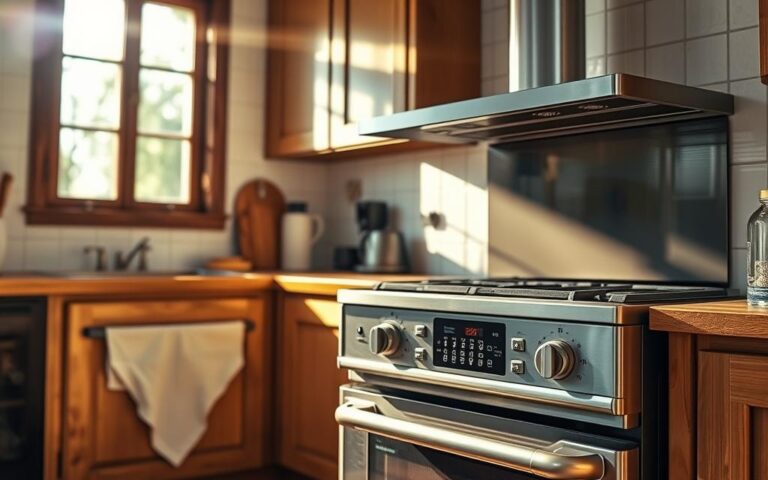The average American household spends nearly $2,000 yearly on energy bills. Cooking appliances contribute significantly to these costs. Energy-efficient stoves offer a smart solution for homeowners looking to cut expenses and reduce environmental impact.
Cost-effective cooking is now a practical approach to managing household expenses. Modern energy-efficient stoves help reduce carbon footprints and save on utility bills. They maintain excellent cooking performance while using less energy.
These advanced appliances use cutting-edge technology to maximize efficiency. They consume less electricity while delivering consistent cooking results. Investing in an energy-efficient stove can lead to substantial long-term savings.
Homeowners can create an eco-friendly kitchen space with the right stove. These appliances balance performance, affordability, and energy conservation. Let’s explore how efficient stoves can transform your cooking experience and save you money.

Understanding Low-Cost Efficient Stoves
Modern kitchens now feature innovative energy-saving appliances that blend performance and sustainability. Low-cost efficient stoves offer a smart way to reduce energy use and lower utility bills. These appliances provide an eco-friendly solution for budget-conscious and environmentally aware consumers.
These stoves maximize cooking efficiency while minimizing energy waste. They use cutting-edge technologies to deliver optimal performance with minimal energy consumption.
What Are Low-Cost Efficient Stoves?
Low-cost efficient stoves are cooking devices that deliver great performance using minimal energy. They use advanced design principles and smart technologies to improve cooking.
These stoves reduce electricity use and minimize heat loss. They also provide precise temperature control and optimize cooking processes.
Key Features to Look For
| Feature | Benefits |
|---|---|
| Induction Technology | Direct heat transfer, faster cooking |
| Programmable Settings | Precise cooking, energy management |
| Auto-shut Off Mechanisms | Prevents energy waste, enhanced safety |
Benefits of Choosing Efficient Stoves
Energy-saving appliances like low-cost efficient stoves offer many advantages. They can significantly reduce monthly energy bills and lower your carbon footprint.
These stoves also enhance cooking performance and provide long-term cost savings. They’re a smart choice for any modern kitchen.
- Significant reduction in monthly energy bills
- Lower carbon footprint
- Enhanced cooking performance
- Long-term cost savings
“Smart cooking starts with smart technology that respects both your wallet and the environment.” – Energy Conservation Expert
Choosing the right low-cost efficient stove can transform your kitchen. It balances performance, affordability, and environmental responsibility. Make a smart choice for your home and the planet.
Types of Low-Cost Efficient Stoves
The right stove can greatly impact your cooking and energy costs. Modern kitchens offer various efficient cooking options. Let’s explore popular types of low-cost efficient stoves.
Electric Cooktops: Sleek and Reliable
Electric cooktops provide a smooth cooking surface that many home chefs love. They offer uniform heat distribution and are easy to clean.
These stoves have a modern design and allow precise temperature control. Modern electric cooktops have become more energy-efficient, reducing electricity use.
- Uniform heat distribution
- Easy to clean flat surface
- Modern aesthetic design
- Precise temperature control
Gas Range Efficiency: Traditional Cooking Power
Gas ranges are popular among professional and home cooks. They offer immediate heat control and a traditional cooking experience.
Gas range efficiency has improved greatly in recent years. They allow instant heat adjustment and have lower operational costs.
- Instant heat adjustment
- Lower operational costs
- Works during power outages
- Preferred by serious home cooks
“A gas stove offers unparalleled cooking precision that electric models struggle to match.” – Professional Chef Review
Induction Cooking Benefits: The Modern Solution
Induction stoves are at the cutting edge of cooking technology. These innovative appliances offer remarkable benefits that set them apart.
They have the fastest heating technology and maximum energy efficiency. Induction stoves also provide cool-to-touch surface safety.
- Fastest heating technology
- Maximum energy efficiency
- Cool-to-touch surface safety
- Precise temperature management
Induction technology heats cookware directly using electromagnetic energy. This results in faster cooking times and big energy savings.
Initial costs might be higher, but long-term benefits make them attractive. They’re a great option for modern kitchens.
Cost-Effectiveness of Efficient Stoves
Energy-efficient stoves may seem pricey at first. However, they offer significant long-term savings. Smart appliance technologies can reduce monthly utility expenses for homeowners.
Efficient stoves require a thorough appliance comparison. Modern models can greatly cut household energy use. They show remarkable potential for reducing consumption.
Initial Investment vs. Long-Term Savings
Stove purchases involve more than just upfront costs. Efficient stoves offer benefits beyond the price tag.
- Lower monthly energy bills
- Reduced maintenance expenses
- Extended appliance lifespan
Energy Consumption Comparison
Energy-efficient stoves use less electricity than traditional models. Homeowners can save up to 30% on cooking-related energy expenses with advanced technology.
Financial Incentives for Energy-Efficient Appliances
Several options make efficient stoves more affordable. These include tax credits, rebates, and incentive programs.
- Federal tax credits for energy-efficient appliances
- State-level energy rebates
- Utility company incentive programs
Energy rebates can greatly reduce purchase costs. This makes efficient stoves a smart choice for budget-conscious homeowners.
Environmental Impact of Using Efficient Stoves
Modern stoves reduce carbon emissions and protect our planet. These eco-friendly appliances minimize environmental impact while delivering great performance. Sustainable kitchen appliances are crucial for a greener future.
Efficient stoves help households cut their carbon footprint. These innovative appliances use less energy, leading to lower greenhouse gas emissions. They’re a powerful tool for eco-conscious consumers.
Reducing Carbon Footprint
Smart appliance choices can make a big environmental difference. Energy-efficient stoves can slash carbon emissions by up to 30% compared to traditional cooking equipment.
- Decreased energy consumption
- Lower greenhouse gas production
- Minimal environmental impact
Energy Conservation Benefits
Modern stoves are built to save energy. Intelligent design features help these appliances use fewer resources while maintaining high performance.
| Stove Type | Energy Savings | Carbon Reduction |
|---|---|---|
| Induction Stoves | 40-50% | 25-35% |
| Electric Efficient Stoves | 30-40% | 20-30% |
| Gas Efficient Stoves | 25-35% | 15-25% |
Sustainable Materials in Stove Manufacturing
Stove makers now focus on eco-friendly production methods. They use recycled metals and energy-efficient processes. Environmentally responsible design is becoming standard in creating green cooking appliances.
“Every sustainable kitchen appliance represents a step toward a greener future.” – Environmental Technology Institute
How to Choose the Right Stove for Your Home
Picking a stove isn’t just about looks. It’s about matching your cooking needs, space, and budget. The right stove can improve your cooking and save you money.

Understanding your needs is key to choosing the right stove. A good sizing guide can help you find a stove that fits your cooking style and kitchen.
Assessing Your Cooking Needs
Your cooking habits matter when picking a stove. Think about how often you cook and what dishes you make.
- Household size and typical meal preparation
- Frequency of cooking
- Types of dishes you typically prepare
- Special cooking requirements
Considering Space and Kitchen Layout
Efficient stoves come in many sizes and styles. Measure your kitchen to ensure a good fit. Check your counter space and connections.
- Available counter space
- Electrical or gas connections
- Ventilation requirements
- Existing kitchen design
“The right stove is not just an appliance, it’s the heart of your kitchen.” – Professional Kitchen Designer
Budgeting for Your New Stove
You don’t need to spend a lot to get an efficient stove. Look for models that save energy and money over time.
- Compare energy efficiency ratings
- Check for rebates or incentives
- Calculate long-term operational costs
- Look for seasonal sales and discounts
Pro tip: Sometimes spending a bit more upfront can lead to significant savings on your energy bills in the long run.
Top Brands for Low-Cost Efficient Stoves
Homeowners often struggle to find affordable, efficient cooktops. The market offers top-rated stoves from reputable makers. These stoves balance performance, energy efficiency, and cost-effectiveness.
Let’s explore standout options that deliver exceptional value. These brands offer innovative cooking technologies at budget-friendly prices.
Bosch: Precision and Efficiency
Bosch excels in affordable, efficient cooktops with its engineering prowess. Their electric and gas ranges offer precise temperature control. You’ll also find energy-saving features and sleek designs.
Whirlpool: Reliable Performance
Whirlpool offers top-rated stoves that are both affordable and reliable. Their ranges feature flexible cooking configurations. Many models include smart technology and come at competitive prices.
Frigidaire: Budget-Friendly Innovation
Frigidaire creates energy-efficient stoves for various cooking needs. Their product line boasts user-friendly interfaces. You’ll find multiple cooking modes and consistent heating technology.
GE Appliances: Advanced Technology
GE Appliances leads with cutting-edge stoves and energy management systems. Their ranges offer smart connectivity options. Many models have Energy Star ratings and robust build quality.
Choosing the right stove involves considering your specific cooking requirements, kitchen layout, and budget constraints.
Installation and Maintenance Tips
Proper stove installation ensures optimal performance, safety, and longevity. A comprehensive guide can help you avoid pitfalls and maximize efficiency.
Several key factors will help you create a smooth setup for your new stove. Consider these elements before installation.
Proper Installation Guidelines
- Measure your kitchen space carefully before purchasing
- Ensure proper electrical or gas connections
- Check voltage requirements for electric stoves
- Verify ventilation and clearance specifications
Routine Maintenance Practices
Regular maintenance can extend your stove’s lifespan and performance. Focus on these critical areas:
- Clean burners and heating elements monthly
- Inspect electrical connections annually
- Check seals and gaskets for wear
- Calibrate temperature settings periodically
Troubleshooting Common Issues
DIY stove repairs can save money and prevent larger problems. Learn to spot warning signs that might need professional help.
- Uneven heating could indicate element malfunction
- Strange noises might suggest internal component issues
- Inconsistent temperature might require recalibration
If you’re unsure, consult a professional technician. This can prevent safety hazards and further damage to your appliance.
Energy-Saving Cooking Tips
Smart cooking strategies can save energy and money. By using efficient methods, you can make your kitchen more sustainable and cost-effective.
These techniques can help you cook smart and use less energy. You don’t have to sacrifice meal quality to be efficient.
Best Practices for Efficient Cooking
- Match pot size to burner size for maximum heat transfer
- Use lids to trap heat and reduce cooking time
- Utilize residual heat by turning off burners early
- Batch cook multiple meals simultaneously
Using Cookware to Maximize Efficiency
The right pots can greatly improve your cooking energy use. Choose flat-bottomed, thick-walled pots with tight-fitting lids for best heat retention.
| Cookware Material | Heat Efficiency | Recommended Use |
|---|---|---|
| Cast Iron | High | Slow cooking, even heat distribution |
| Copper | Very High | Quick, precise temperature control |
| Stainless Steel | Moderate | Versatile cooking techniques |
Meal Prepping for Energy Savings
Smart meal planning reduces electricity use and kitchen time. Prepare multiple meals at once to cut down on energy consumption.
Cook in batches to save time and energy. This method helps you work smarter in the kitchen.
“Smart cooking is about working smarter, not harder—and definitely not more expensively.” – Culinary Energy Expert
Pro tip: Invest in a slow cooker or pressure cooker to streamline meal preparation and reduce energy usage.
Customer Reviews and Experiences
User reviews of efficient stoves offer valuable insights into energy savings and appliance performance. Homeowners across the U.S. have shared amazing stories about cutting energy bills through smart choices.
These stories reveal how upgrading appliances can lead to significant cost reductions. Real-world experiences highlight the benefits of energy-efficient stoves.
Customer feedback points to several key advantages of energy-efficient stoves. These include lower energy bills, better cooking performance, and improved kitchen looks.
Users also report a reduced environmental impact from their new appliances. These benefits make efficient stoves an attractive option for many homeowners.
- Substantial reduction in monthly energy expenses
- Improved cooking performance
- Enhanced kitchen aesthetics
- Lower environmental impact
Real-Life Savings Stories
Sarah Martinez from Phoenix shared her experience: “After switching to an energy-efficient induction stove, my monthly electricity bill dropped by 22%. The initial investment paid for itself within 18 months.”
Sarah’s story shows the real financial benefits of modern appliances. Many users report similar savings after upgrading their stoves.
Common User Complaints and Resolutions
While most reviews are positive, some users face initial challenges. The most common concerns include learning new technology and higher upfront costs.
Compatibility with existing cookware is another issue some users encounter. However, manufacturers are working to address these problems.
- Learning curve with new technology
- Higher upfront costs
- Compatibility with existing cookware
Companies now offer better user manuals and installation support. They’ve also created more affordable models to help more people access this technology.
Customer support teams provide detailed guidance to maximize appliance efficiency. These efforts help users overcome initial hurdles and enjoy their new stoves.
Professional energy auditors consistently recommend upgrading to efficient stoves as a smart long-term investment.
Comparing Energy Efficiency Ratings
Energy Star certified stoves can be confusing. Understanding efficiency ratings is key for smart purchases. These choices affect your budget and the environment.
Efficiency ratings show how well appliances perform and use energy. They help you choose stoves that will save money over time.
Understanding Energy Star Certification
Energy Star certified stoves go through tough testing. They must meet strict energy standards. The process involves thorough energy use tests.
- Comprehensive energy consumption testing
- Verification of efficiency performance
- Compliance with government-established guidelines
How Ratings Impact Your Energy Bill
Appliance efficiency ratings directly affect your monthly energy costs. A higher-rated stove can cut energy use by 10-50% compared to standard models.
Comparing Stoves Based on Ratings
When comparing energy use, look at these key factors:
- Annual energy usage estimates
- Energy Star certification level
- Estimated cost savings
By evaluating these ratings carefully, you can pick stoves that are highly efficient. This helps minimize energy waste and save money.
Future Trends in Stove Technology
Smart cooking technology is transforming kitchen appliances with unprecedented innovations. Manufacturers are developing stoves that cook efficiently and integrate with digital ecosystems. New designs promise enhanced energy performance and intelligent connectivity.
Samsung and LG are investing heavily in research for smart stoves. These appliances have sensors to monitor temperatures and suggest cooking times. They can connect to smartphone apps for remote control.
These advancements make cooking more precise, convenient, and energy-efficient. Affordable smart stoves are becoming more accessible as costs decrease and competition grows.
AI-powered cooking algorithms and multi-zone induction surfaces are set to revolutionize home cooking. Consumers can expect more intuitive appliances that simplify meal preparation. These stoves will also reduce overall energy consumption.
Experts predict smart cooking technology will be standard in most kitchens within five years. Artificial intelligence, internet connectivity, and advanced materials will drive stove design innovation.
These changes will make cooking more sustainable, efficient, and enjoyable for home chefs. The future of kitchen appliances looks incredibly promising for Americans.
FAQ
What are the main benefits of choosing an energy-efficient stove?
Energy-efficient stoves offer big perks. They lower energy bills and reduce carbon footprints. These stoves use less power, saving money and helping the environment.
How much money can I actually save by using an efficient stove?
You can save 10-30% on energy costs yearly. For an average home, that’s $50-$150 saved annually. Over time, you could save $500 or more.
Are energy-efficient stoves more expensive to purchase?
Efficient stoves may cost more upfront. But long-term savings often make up for it. Many models are priced well. Incentives like tax credits can lower costs too.
What should I look for when buying an energy-efficient stove?
Check for Energy Star ratings and energy use metrics. Consider size and cooking style compatibility. Look for precise controls and smart tech features.
Do energy-efficient stoves perform as well as traditional models?
Modern efficient stoves often work better than old ones. They offer precise control and faster heating. Brands like Bosch and GE have improved both efficiency and cooking quality.
Which type of stove is most energy-efficient?
Induction stoves are the most efficient. They transfer about 90% of energy to cooking. Electric stoves transfer 74%, while gas stoves only 40%. Efficiency can vary by model.
How can I maximize my stove’s energy efficiency?
Use the right size cookware and keep burners clean. Cook with lids on and match pot sizes to burners. Regular maintenance helps improve energy performance too.
Are there government incentives for purchasing energy-efficient stoves?
Many states offer tax credits and rebates. Check with local utilities and state energy offices. These programs can help lower the cost of efficient stoves.
How do energy-efficient stoves impact the environment?
These stoves use less energy, cutting greenhouse gas emissions. They help save natural resources. Choosing one supports sustainable living practices.
What maintenance is required for an energy-efficient stove?
Clean burners and check seals regularly. Calibrate temperature settings when needed. Get professional inspections every few years. Good maintenance ensures top performance and a longer life.




